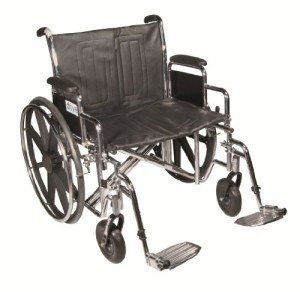Extra Wide Bariatric Wheelchair With 24" Seat
Frame

Wheelchairs are typically produced in a standard width of 16" (narrow adult), 18" (basic adult) or 20" (wide grownup). Nevertheless, some wheelchair users require a seat width broader than these standards. These additional large bariatric wheelchairs are typically fitted by an expert and based upon the user's measurements.
In order to get the most comfortable and safe and secure trip for travelers, it is essential that wheelchairs are properly sized. This suggests that the wheelchair needs to be able to accommodate the user's size while having the ability to navigate in tight areas. This is why BriteLift offers tailored vehicles to transport wheelchair travelers. This includes vans that can securely drive and steer big wheelchairs, allowing them to feel safe and comfortable in every trip. This is the only way to supply the most efficient transport for wheelchair guests.
Seat
Bariatric wheelchairs are larger than standard wheelchairs and are developed to accommodate individuals who are much heavier or wider. This additional large bariatric wheelchair from Medline includes a 24" seat and a carbon steel frame with rust- and chip-resistant chrome plating. The wheelchair has tool-free push-button adjustable footrests and easy-to-clean vinyl upholstery. It can support as much as 500 lbs.
When choosing the ideal wheelchair width, it is very important to measure the user sitting typically on a flat surface area across their widest part of the lap which is normally their hips. It is likewise suggested that you use a yardstick rather than a determining tape as it tends to provide a more accurate measurement. If the user will be wearing a winter coat then an additional 2" should be added to the measurement of their seat width.
Weight Capacity
A bariatric wheelchair is typically larger and heavier than basic wheelchairs. This is why they require more careful maneuvering. Motorists require to be trained in dealing with these guests. Moreover, cars need to have adequate space for these chairs along with ramps and wheelchair lifts. In addition, they require to know how to arrange these rides beforehand.
When deciding on the chair width, it is important to measure the user's widest point in the seat, which is normally the hips. Many wheelchair manufacturers also offer a yardstick that can be used to assist with this measurement. When measuring bariatric wheelchair weight , it is best to take the measurement straight throughout and not wrap the tape around their hips which can offer a false reading.
In many cases, the widest part of an individual's thighs might be wider than their hips so this need to be considered when choosing the chair width. In these circumstances, it is often essential to add an extra 2" to the chair width.
In basic, the weight capacity of a bariatric wheelchair should not be exceeded under any situations or major injury might result. When using the chair, constantly be sure that it is on a steady and level surface with front casters pointing forward and wheel locks engaged. In addition, never lean or shift the center of gravity while being in the chair.
